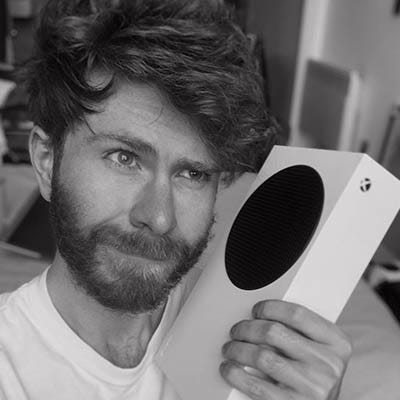Auditory tales from the making of zen puzzler UnpackingAuditory tales from the making of zen puzzler Unpacking
"Because there was so much space, there was so much time for us to sit there and appreciate the quality of the sounds."

If you've played Unpacking, the zen and rather emotional puzzler from Witch Beam about moving between homes, you'll have already come to appreciate the domestic symphony that helps being each unique object to life.
As noted by composer and sound designer Jeff van Dyck, speaking at GDC 2022, the title leverages over 14,000 foley audio files to imbue each of Unpacking's inanimate objects with life.
That's a lot of sounds, but given Unpacking's core gameplay loops involves moving objects from one surface to another -- pulling them out of boxes and placing them on worktops, tables, bathroom counters, beds, and more -- it was important to use audio to chart each object's journey to its proper place.
According to Dyck, the team initially flirted with the idea of using chip-tune effects that would reflect the game's pixel art sensibilities, but after a bit of consideration decided to pursue a hyper-realistic style that would allow for the inclusion of detail.
Dyck felt that realistic sound effects would serve as a welcome contrast to Unpacking's impressionistic visuals, and noted how the sparse game world would allow the audio to take centre stage.
"Because there was so much space, there was so much time for us to sit there and appreciate the quality of the sounds," noted Dyck, who suggested the fact there "wasn't much going on" in Unpacking's world compared to other titles was actually a "big advantage" as far as audio was concerned.
The sounds of life
As Unpacking progressed from prototype to full-blown production, Dyck explained the scope increased exponentially. The team had ambitions to let players move objects between multiple rooms, which meant Dyck would have to create more audio effects to facilitate the sprawling array of interactions players might attempt.
At one point early in development, Dyck outlined a plan to record audio for 500 items, 15 surfaces, and 10 variants -- that latter of which would be used to ensure players didn't always hear the same sound when repeating a placement -- that would've resulted in 75,000 audio files. It quickly became apparent that wouldn't necessarily be feasible, prompting some improvisation from the sound designer.
In order to cut that number down, Dyck trialed a number of different approaches -- collaborating with his wife Angela van Dyck and daughter Ella van Dyck, both of whom also work in the world of audio -- to refine his process for pulling sounds into the game and squeezing as much out of each file as possible.
"The items we recorded were very literally the things that are in the game," he recalled, explaining how he worked with Ella during the early stages of production with a focus on one-to-one accuracy. "We didn't use that classic foley artist technique of using one item to mimic another. We did record, as much as possible, the actual item. Maybe where we improved was what we were using for the surfaces."

Further down the line, it became clear there could be some overlap between items, allowing Dyck to capture "generic" sounds that could be repurposed in a number of ways.
"A lot of items sounded similar, so we started recording generic materials to share among items -- so, for example, rather than recording a toothbrush, we could recording something called 'plastic light' that could be used on anything that was light and made out of plastic. Then we had 'glass' and 'ceramic' and so on," he explained.
Dyck also recalled how the pick-up audio -- the noises that play when players grab objects -- was designed to be short and punchy. "You have to remember in Unpacking the pick-up animation is one frame," he continued. "It goes from un-picked-up to picked-up, and so having a sound that was slow felt laggy. We kept everything tight so it felt responsive and tactile."
Another time-saving technique Dyck employed was to implement a rock-paper-scissors type scenario that would determine what sound to play when two materials interact, ultimately selecting the softest material as the "winner."
"When two materials hit each other, the softest material wins and becomes the predominant sound," he explained. "An example is when you have a metal cup and a wooden cup on a hard table. If you put the metal cup down you'd hear the metallic sound. Put the wooden cup down and you'd hear the wooden sound. Put those two objects on a soft bed, however, and they'd sound identical, which means I don't need to record those two things 'on bed' -- I just need a generic thing called 'object light on bed.'"
'Sweeteners' were also used to imbue generic sounds with more personality and flavor. "For example, we have this 'cup' sound, but we also have this other 'cup' that's got pencils in it and they shake around when you move it. So we just recorded the sweetener of pencils shaking around and played that while using the shared 'cup' sound," added Dyck. "We had this library of sweeteners that didn't need to be recorded on different surfaces because it's more about the sound of objects interacting with each other."
Some audio effects were also accentuated using a dynamic shake system created in Wwise. In-game, the system tracks mouse movement to determine whether a sound needs to be soft or aggressive. For instance, if a player grabs the piggy bank and moves it slowly, they might hear the quiet jingle of change. If, however, they fling it around with maniacal verve, they'll hear coins aggressively rattle and clank. It's a little touch, but one that breeds immersion.
Outside of those generic sounds and sweeteners, there are some objects that will always play a unique sound. Dyck described those items as "hero objects," and noted it was important to make sure those special items, such as the ukulele, would always surprise and delight players with unique effects. Notably, there's also a duck that quacks when placed down. That idea was the brainchild of Angela, a veteran foley and dialogue producer in her own right, and for that we thank her eternally.

Read more about:
FeaturesAbout the Author
You May Also Like

